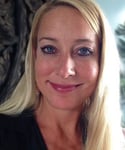A guest post by Bonnie Bright, Ph.D.
Dr. Pat Katsky is a Jungian Analyst and core faculty at Pacifica Graduate Institute, and she has been a therapist for thirty years. When Pat sat down with me in a recent interview, our conversation focused on the idea that some of the most psychologically healing experiences come from the natural world, a theme derived from an upcoming certificate program, “Dreaming the Earth: Earthing the Dream” starting April 15, 2016.
 Pat mused on how in the last million or so years of history, humans have always needed nature and did not feel separate from it. But with the industrial revolution and the development of society as we know it, we have lost the connectedness. It has become something we do for vacation, she observes, then we return to jobs and daily life where nature is distant.
Pat mused on how in the last million or so years of history, humans have always needed nature and did not feel separate from it. But with the industrial revolution and the development of society as we know it, we have lost the connectedness. It has become something we do for vacation, she observes, then we return to jobs and daily life where nature is distant.
Knowing Pat is a Jungian analyst, I ask her how she believes our dreams shed light on our connection to the planet. Dreams are the deepest part of us speaking to us, sharing wisdom and perspective, she responded, noting how Jung used the word numinous to describe certain kinds of dreams that make us feel we are in the presence of something larger than ourselves—when we feel awe or a sense of mystery.
As an analyst, she has seen many “big” dreams—that is, life-changing dreams clients from clients that involved the natural world. She recounts some stories (which, she notes, she has permission to share). Some dreams, for example, introduce a particular animal which becomes a totem figure for the dreamer. In one specific dream, an individual found himself standing on the ground, which began to shake. In the dream, the dreamer thought he was experiencing an earthquake, but then became aware it was a giant animal shaking itself awake. Other clients have had images about unusual movements of stars, or of the sun and moon in an unexpected relationship to one another. As you might imagine, Pat insists, some of these kinds of powerful images can have lasting, life-changing effects on people.
I ask Pat how she recommends people work with the images they receive, particularly for those individuals who are longing for that sense of reconnection with earth. One of the beautiful things about nature is that it exists both inside of us and outside of us, Pat notes in response. For some people, their greater sense of connection with the earth requires them to do something in the outer world, whether cultivating a garden or visiting certain natural settings.
Pat mentions that the certificate program she is co-teaching at Pacifica will incorporate some special elements, including community dreaming where people gather at the beginning of the day and share dreams. Often themes emerge throughout the day that echo the images that came out of the group dream work in the morning. Among other experiential activities, participants will also have the opportunity to use art supplies or nature elements to engage with a dream image.
Are there other practices, I wonder to Pat, that can be used to enhance our engagement? She responds with her own enthusiasm about topics that will be included in the upcoming certificate program, including a presentation from Pacifica’s organic gardener whom she likens to the “archetypal green man,” Dr. Steve Aizenstat, who will be presenting on DreamTending™, and Dr. Joseph Cambray, who will speak about complex adaptive systems. We are increasingly discovering that as a system develops, new more complicated order can evolve—a rather radical idea, as Pat notes. Cambray will also go into the biological basis of how our mind works when we go into natural settings. Dr. Joseph Bobrow, a zen roshi, will talk about Buddhism and interdependence in the natural world, and Linda Buzzell will present with Craig Chalquist on eco-resilience—how to find a path forward with heart in the midst of the difficult times we face, and the need to forge a different kind of relationship with the natural world than we currently have as a species.
I ask Pat then if her calling to work as a therapist and provide a container for people to do that kind of work was based in any way on her relationship to nature and what she saw happening on the planet even 20 or 30 years ago. For her personally, she finds something so replenishing about being in nature in that way after immersing herself in the psychic life of so many as a therapist. There’s something that can’t be put into words, Pat insists, about experiencing remote natural settings where one can access very meditative places of deep silence. There we can let nature speak to us, and gift us its gifts to enrich us, giving us the capacity to go back and help others.
Katsky is currently a docent in a nature preserve owned by UCSB, which offers trips into nature for school children and the general public, and she mentions to me how greatly she has enjoyed watching people make that step and to see what it does for them. I am reminded of a talk I heard at a women’s conference a couple of years ago, where the speaker, who was from India, mentioned that in some of the worst slums in India, kids had never seen a tree except in a book. That just broke my heart when I heard that, I tell Pat, and it makes me appreciate the work she is doing to make nature more accessible to kids and everyone.
I think about the wonder of seeing a tree, and query Pat on how she feels about wonder and awe in our culture today? Have we lost the capacity for it, I wonder. What role does it play for us moving forward into the future? Pat has a ready answer. Jung said the main focus of his work was not on pathologies but on the approach to numinous experiences—of awe and of being in the presence of the sacred. He felt that that was the direction in which he wanted people to move, because he believed having these experiences is what healed people. When you have a numinous experience, it’s not something you can ignore she expounds. It’s like a puzzle; sometimes you have to “puzzle over it” for years sometimes to ascertain the range of its meaning.
When you work with numinous experiences, you get the sense that you’re engaged in a dialogue with “a kind of inner wisdom that will give you dreams, synchronicities and knowledge you need to help you continue the path of your own individuation,” she believes.
For me, this evokes the memory of one of my favorite teaching from Jung, who asked, “Is man related to something infinite or not? That is the telling question of his life.”
 When I quote this, Pat responds with another idea from Jung, that personal human growth is like the growth that comes out of a rhizome. Rhizomes, she clarifies, are an extraordinary class of plants where the roots go out sideways. You don’t know it when it’s happening but suddenly a new plant emerges that looks like a separate plant, but it’s actually living off of this much larger rhizome. It can be transformational to think of ourselves in this way, as not separate beings but rather feeding off of this larger rhizome.
When I quote this, Pat responds with another idea from Jung, that personal human growth is like the growth that comes out of a rhizome. Rhizomes, she clarifies, are an extraordinary class of plants where the roots go out sideways. You don’t know it when it’s happening but suddenly a new plant emerges that looks like a separate plant, but it’s actually living off of this much larger rhizome. It can be transformational to think of ourselves in this way, as not separate beings but rather feeding off of this larger rhizome.
As we close the interview, I am left with this image of the rhizome, which has continued to work me, almost as a dream might do. It is but one of millions of metaphors that come to us from the natural world that we can relate to strongly. Nature is indeed a remarkable teacher, and engaging with it intentionally and appreciatively can only enhance our own personal growth.
Listen to the full interview with Pat Katsky here (Approx. 29 mins.)

Pat Katsky, Ph.D., has been a core faculty member at Pacifica for over 15 years, teaching and mentoring students in many of Pacifica’s programs. She is currently serving as Vice-Provost, and formerly was Chair of the Depth Psychotherapy Program. She was certified as a Jungian analyst 20 years ago, and has been a psychotherapist for over 30 years. Her research interests include the process of becoming a psychotherapist, the world of dreams, and the religious function of the psyche. She has published and lectured on these topics in the United States and abroad. Pat was formerly the president of the C.G. Jung Institute of Los Angeles, and serves regularly on the reviewing and certifying boards of the San Francisco and Los Angeles Jung Institutes. She co-founded a non-profit counseling center in Los Angeles, Counseling West, which serves individuals, couples, and families seeking a depth psychotherapeutic approach in charting a path in their lives, and she continues to participate in this organization as a member of the board of directors.
 Bonnie Bright, Ph.D., graduated from Pacifica’s Depth Psychology program after defending her dissertation in December 2014. She is the founder of Depth Psychology Alliance, a free online community for everyone interested in depth psychologies, and of DepthList.com, a free-to-search database of Jungian and depth psychology-oriented practitioners. She is also the creator and executive editor of Depth Insights, a semi-annual scholarly journal, and regularly produces audio and video interviews on depth psychological topics. Bonnie has completed 2-year certifications in Archetypal Pattern Analysis via the Assisi Institute; in Technologies of the Sacred with West African elder Malidoma Somé, and has been extensively involved in Holotropic Breathwork™ and the Enneagram.
Bonnie Bright, Ph.D., graduated from Pacifica’s Depth Psychology program after defending her dissertation in December 2014. She is the founder of Depth Psychology Alliance, a free online community for everyone interested in depth psychologies, and of DepthList.com, a free-to-search database of Jungian and depth psychology-oriented practitioners. She is also the creator and executive editor of Depth Insights, a semi-annual scholarly journal, and regularly produces audio and video interviews on depth psychological topics. Bonnie has completed 2-year certifications in Archetypal Pattern Analysis via the Assisi Institute; in Technologies of the Sacred with West African elder Malidoma Somé, and has been extensively involved in Holotropic Breathwork™ and the Enneagram.



